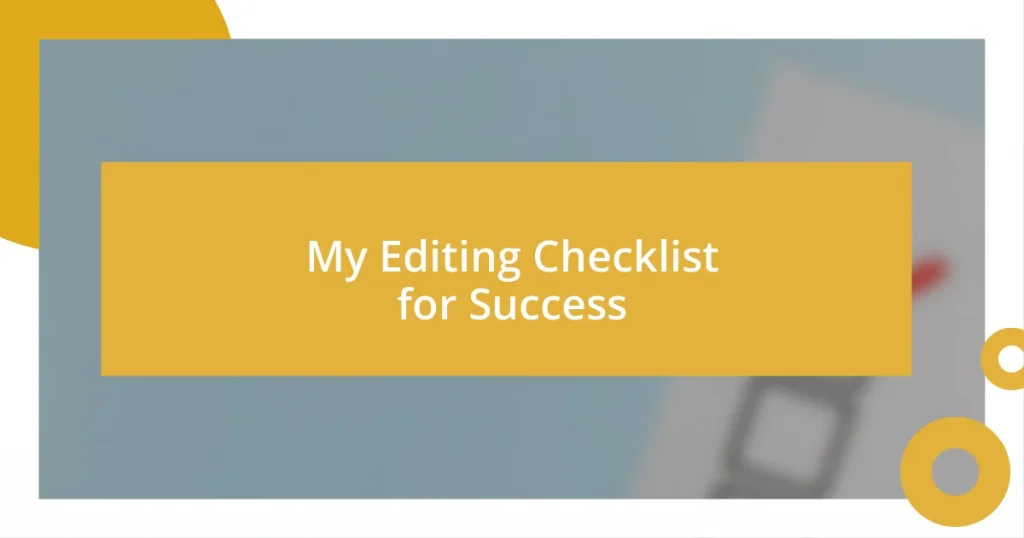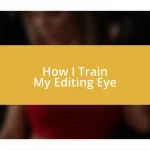Key takeaways:
- Editing is a transformative process that goes beyond correcting errors; it involves refining one’s voice and ensuring clarity in writing.
- Creating a comfortable editing environment, gathering proper tools, and setting clear goals are essential steps to enhance the editing process.
- Continuous improvement through feedback, journaling lessons learned, and staying updated with writing trends is crucial for refining editing skills.

Understanding the editing process
Editing is often perceived as just a technical task, but for me, it’s more like a deep dive into my own thoughts. I remember the first time I edited a piece I was passionate about; each word felt like a thread unraveling a tapestry. How do you weave the right ones back in? That question often guides my editing journey.
When I began to understand that editing isn’t merely about correcting grammar or spelling, but about honing my voice and clarity, my writing transformed. I started viewing each draft as a living document, evolving with each round of edits. Isn’t it fascinating how a simple word swap can shift the entire tone of the piece?
Reflecting on my experiences, I’ve found that taking a break between writing and editing helps me approach my work with fresh eyes. It’s almost like stepping away from a painting; when I return, I can see the strokes that need softening or boldness. Have you experienced that moment when you catch a mistake you would have otherwise missed? It’s both humbling and enlightening.

Preparing for effective editing
Preparing for effective editing involves a careful mindset and environment. I often find that creating a comfortable space helps me focus better. When I settled into my cozy corner with a cup of tea, I felt more at ease. That shift in atmosphere surprisingly enhances my editing prowess.
Before diving into the editing process, I always make sure to gather my tools. Whether it’s a reliable thesaurus or my favorite notebook, those resources are essential. I remember a time when I forgot my notes and struggled to articulate a crucial argument. It was a reminder that preparation can save invaluable time and effort.
Setting clear goals is another essential step. I like to outline what I want to achieve during each editing session. For instance, I focus on clarity in one round, then shift to enhancing tone in another. This structured approach prevents me from feeling overwhelmed and keeps the editing process manageable. Isn’t it interesting how breaking tasks into smaller, focused segments can make the work feel less daunting?
| Preparation Steps | Description |
|---|---|
| Create a Comfortable Space | Find an environment that makes you feel relaxed and focused. |
| Gather Your Tools | Ensure you have all necessary resources at hand for quick access. |
| Set Clear Goals | Outline specific objectives for each editing session to maintain focus. |
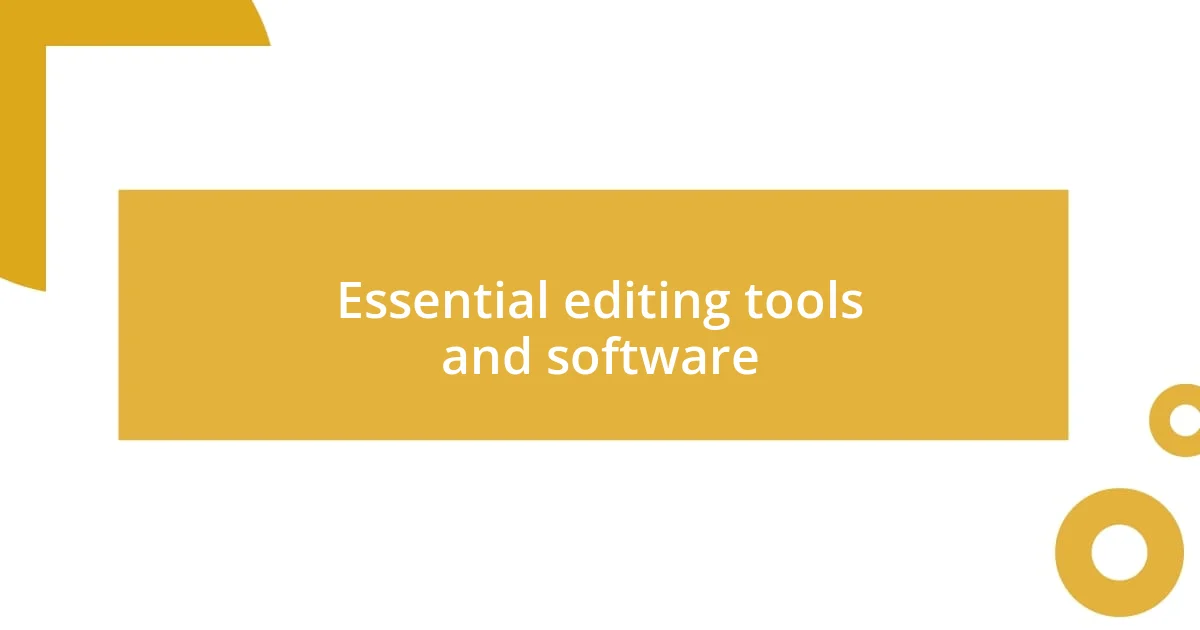
Essential editing tools and software
When it comes to editing, having the right tools can make a significant difference. I still remember my first experience using Grammarly—what a game changer! It was like having a helpful friend by my side, pointing out areas where I could tighten my prose or enhance clarity. These tools not only save time but also allow me to focus more on the creative aspects of writing rather than getting bogged down in technicalities.
Here are some essential editing tools and software that I find incredibly useful:
- Grammarly: For grammar, punctuation, and style suggestions.
- Hemingway Editor: To enhance readability by highlighting complex sentences.
- ProWritingAid: Perfect for detailed reports on writing style and structure.
- Evernote: Helps organize notes and research efficiently for easy access.
- Microsoft Word: The traditional word processor with robust editing features, including track changes.
Having these tools at my disposal has truly elevated my editing process. I recall an instance when I used the Hemingway Editor for a piece I was particularly anxious about. It highlighted overly complex sentences I didn’t even know I had written. Realizing that I could simplify my ideas made my writing clearer and resonated better with readers. It’s that kind of insight that I believe every writer can benefit from during their editing journey.
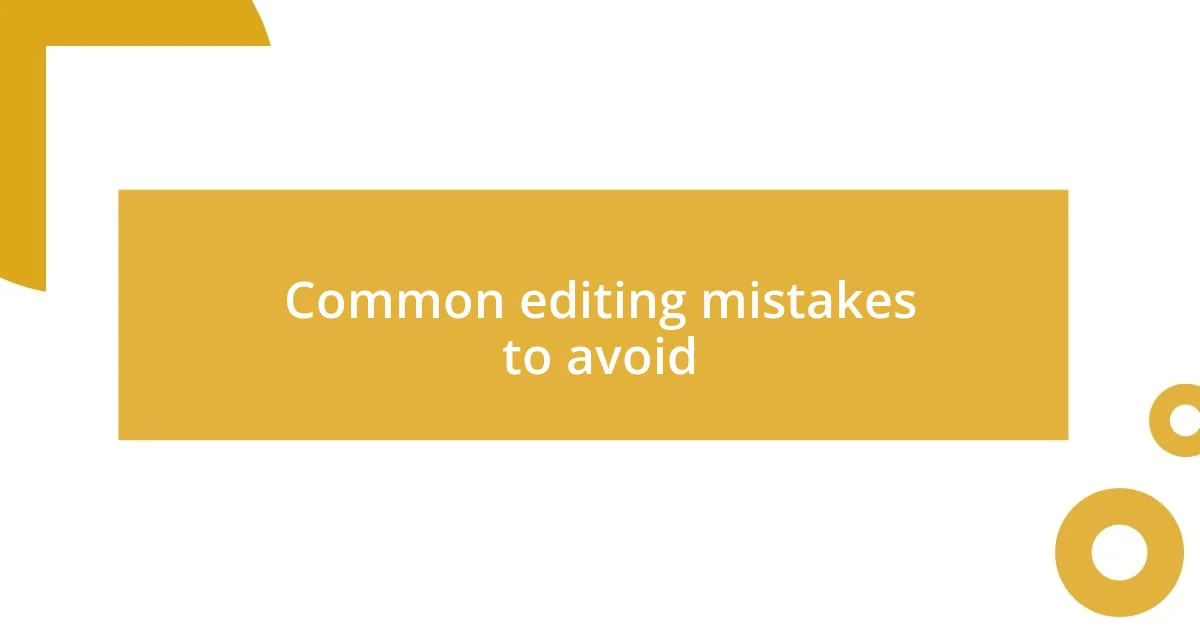
Common editing mistakes to avoid
Even seasoned writers can fall prey to common editing mistakes. One that often sneaks up on me is overlooking repeated words or phrases. I recall once submitting an article only to find “the” appeared nearly ten times in a single paragraph. It felt embarrassing—and it could have been avoided with just another read-through. Have you ever had a similar experience?
Another frequent pitfall is getting too attached to our original words. I remember a story I was particularly proud of, but upon reflection, the beginning felt tedious and wordy. It was challenging to strip away those cherished phrases. Yet, making those cuts ultimately allowed the story to shine. How liberating it can be to let go, even when it feels tough!
Also, I can’t emphasize enough how crucial it is to check for consistency in style and formatting. I once had a document filled with various font sizes and bullet points that seemed to change mid-paragraph. It felt chaotic, and it distracted from the content’s message. A final read to ensure everything flows smoothly can truly elevate the reader’s experience. Paying attention to these details reflects not just on our work but also on our professionalism as writers.

Strategies for improving clarity
It’s fascinating how simple strategies can revolutionize the clarity of your writing. One technique I often use is to read my work aloud. This might sound basic, but trust me, it unveils awkward phrasing and convoluted ideas that I might miss while reading silently. Have you ever tried this? It’s like hearing your writing with fresh ears—the rhythm and flow come to life, allowing for smoother adjustments.
Another effective method is to implement shorter sentences and paragraphs. I remember working on a complex article about a technical subject. Initially, my paragraphs were long and packed with information. After breaking them down, the content became digestible. This shift not only helped my readers grasp the concepts better, but it also eased my own writing process, making it feel less overwhelming. Isn’t it amazing how simplicity often leads to better understanding?
Lastly, eliminating unnecessary jargon is a strategy I can’t stress enough. I recall a particular piece where I used specialized terms without realizing they could confuse my audience. After editing to use more straightforward vocabulary, I received feedback that the message was much clearer. It taught me that clarity often lies in the choice of our words. If I can connect with my readers using simple language, why wouldn’t I?

Finalizing your editing checklist
Finalizing your editing checklist involves a careful review of your work to catch any lingering issues. I remember the time I thought my article was polished, only to discover a glaring inconsistency in my list formatting. Having a checklist helped me catch that oversight, saving me from a potential embarrassment. Do you have a final check routine before sending off your work?
I find it invaluable to take a break before the final review. Stepping away for a short while gives me the distance needed to see my work with fresh eyes, allowing me to spot errors I previously overlooked. Last week, after taking a breather, I noticed that a crucial argument was buried under unnecessary detail, which I promptly trimmed away. Doesn’t it feel refreshing to spot those hidden flaws after a little time apart?
Another essential aspect of finalizing my editing checklist is ensuring all my sources are properly cited and accessible. I recall submitting a paper where I failed to check my hyperlinks, and some led to dead ends. It wasn’t just frustrating for me but for my readers too. Wouldn’t you agree that ensuring accessibility can greatly enhance the credibility of our work? Keeping these details in mind as you finalize your checklist will surely elevate your writing to a more professional standard.
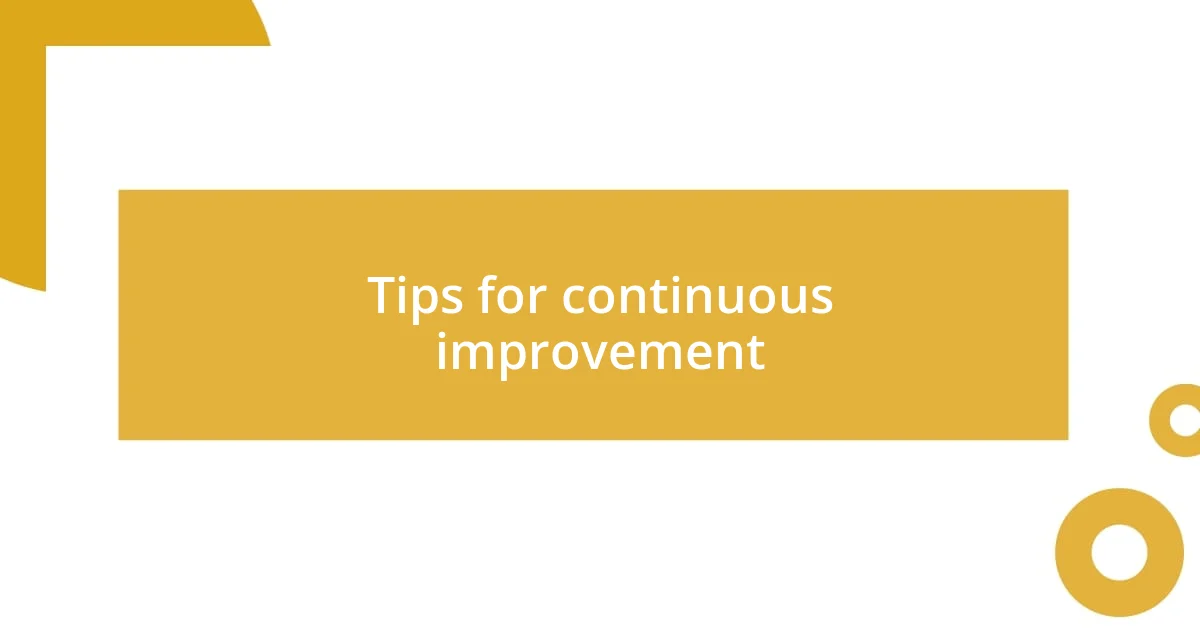
Tips for continuous improvement
Embracing continuous improvement in editing is essential for honing my skills. One practice I’ve found incredibly helpful is seeking feedback from peers or mentors. When I first started publishing my articles, I was hesitant to share my work for critique. But after opening up to constructive criticism, I discovered invaluable insights that had me rethinking my writing approach. How often do you ask others for their perspective? I’ve learned that a fresh pair of eyes can illuminate aspects I might overlook and drive my writing to new heights.
Another tip I swear by is keeping a journal of lessons learned from each editing experience. I’ve made it a habit to jot down mistakes I made and what I did to correct them. For instance, there was a time I repeatedly misused commas, and after dedicating space in my journal to track my progress, I finally mastered it. Reflecting on these moments not only solidifies my learning but also provides motivation as I see how far I’ve come. Have you documented your editing journey? I believe it can be a great source of encouragement when you see how much you’ve improved over time.
Lastly, I like to stay informed about the latest trends and techniques in writing and editing. I often skim through blogs and articles to absorb new tips and strategies. Recently, I learned about the power of visual aids in enhancing content—something I hadn’t fully considered before. By incorporating these techniques into my checklist, I continually adapt and refine my approach. How do you keep your skills sharp? By committing to lifelong learning, I find that every new piece of information adds to my toolkit, ultimately making me a better writer.










